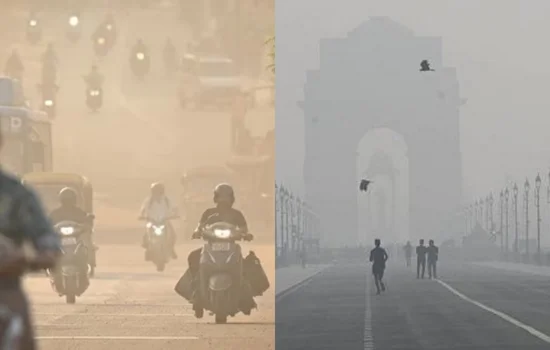Delhi’s air pollution crisis has escalated, prompting the implementation of Stage III of the Graded Response Action Plan (GRAP). With the city’s Air Quality Index (AQI) slipping into the “very poor” category, authorities have introduced stringent measures, including a ban on BS-IV diesel vehicles, to mitigate the alarming situation.
Rising Air Pollution Levels in Delhi
The AQI in Delhi has reached critical levels, with PM2.5 and PM10 pollutants far exceeding permissible limits. This seasonal spike in air pollution is attributed to factors such as vehicular emissions, industrial activities, and adverse weather conditions, including low wind speeds and temperature inversions, which trap pollutants closer to the ground.
According to the System of Air Quality and Weather Forecasting and Research (SAFAR), the city’s AQI recorded levels between 350 and 400, classifying it as “very poor.” This category signifies a high risk to health, especially for vulnerable populations, including children, the elderly, and those with pre-existing health conditions.
GRAP III Measures to Combat Delhi Air Pollution
To tackle the deteriorating air quality, the Commission for Air Quality Management (CAQM) has activated Stage III of GRAP. Key measures include:
- Ban on BS-IV Diesel Vehicles: Non-essential BS-IV diesel vehicles are prohibited in Delhi-NCR, excluding those involved in essential services. This is expected to curb vehicular emissions, a major contributor to Delhi’s pollution.
- Halt on Construction Activities: All non-essential construction and demolition activities have been suspended to reduce dust pollution, a significant source of particulate matter.
- Closure of Industrial Units: Industries that do not operate on clean fuels have been ordered to shut down temporarily.
- Enhanced Public Transport: Public transportation services, including buses and metro trains, will be increased to discourage the use of private vehicles.
Public Health Advisory
Authorities have issued advisories urging residents to adopt protective measures against Delhi’s air pollution. Citizens are advised to:
- Stay Indoors: Limit outdoor activities, especially during early morning and late evening when pollution levels are highest.
- Wear Masks: Use N95 or higher-grade masks to reduce exposure to harmful pollutants.
- Use Air Purifiers: Install air purifiers at home to improve indoor air quality.
- Follow Health Guidelines: Vulnerable groups, such as individuals with respiratory conditions, are advised to consult healthcare professionals for preventive measures.
Efforts to Address the Crisis
The Delhi government, in collaboration with CAQM, has initiated several long-term and short-term measures to combat air pollution:
- Promotion of Electric Vehicles (EVs): Incentives are being provided to accelerate the adoption of EVs, reducing reliance on fossil fuels.
- Green War Rooms: Real-time monitoring of air quality is being conducted to implement immediate corrective actions.
- Anti-Smoke Guns and Water Sprinklers: Deployed in high-pollution zones to settle dust particles.
Challenges Ahead
Despite these efforts, Delhi continues to face significant challenges in managing air pollution:
- Stubble Burning: Crop residue burning in neighboring states remains a persistent issue, contributing significantly to Delhi’s pollution during winter.
- Vehicular Emissions: The high number of vehicles on Delhi’s roads adds to the pollution burden, necessitating stricter enforcement of emission standards.
- Lack of Public Awareness: Educating citizens about pollution sources and preventive measures remains a critical need.
Impact of GRAP III Measures
The implementation of GRAP III is expected to have a noticeable impact on air quality if strictly enforced. However, experts emphasize the need for long-term strategies to address the root causes of Delhi’s air pollution. These include investments in renewable energy, enhanced public transportation networks, and stricter industrial regulations.
Conclusion
Delhi’s air pollution crisis is a stark reminder of the urgent need for collective action and sustainable solutions. While GRAP III measures are a step in the right direction, sustained efforts from authorities, industries, and residents are crucial to achieving cleaner air. For now, the focus remains on mitigating the immediate health risks posed by hazardous air quality and ensuring compliance with anti-pollution regulations.
As Delhi battles this perennial issue, the need for a comprehensive and collaborative approach has never been more critical.

Hello, I’m Kapil Kumar, a seasoned SEO expert and blogger at WinnersList.in. My mission is to spotlight exceptional individuals and organizations across various domains. Through curated lists, profiles, and inspiring stories, I aim to celebrate outstanding achievements and inspire the next generation of champions. Join me in this journey.

